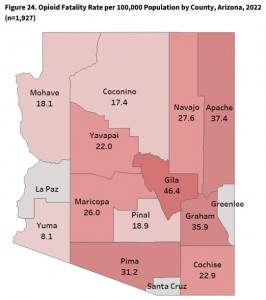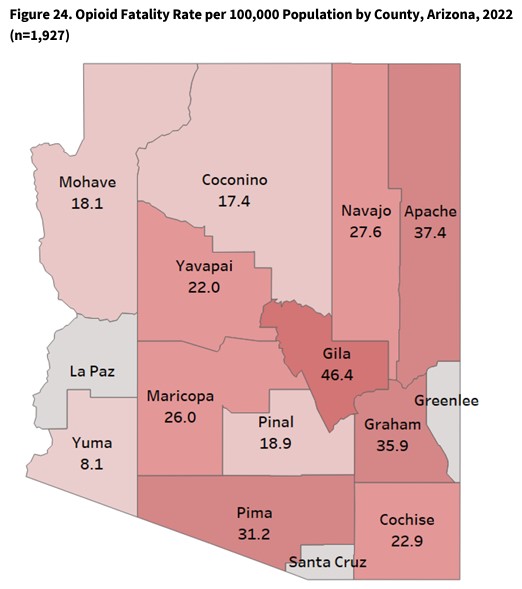 The state of Arizona, along with the rest of the nation, is confronting a troubling surge in opioid-related overdose deaths, with illicit fentanyl and other synthetic opioids playing a pivotal role.
The state of Arizona, along with the rest of the nation, is confronting a troubling surge in opioid-related overdose deaths, with illicit fentanyl and other synthetic opioids playing a pivotal role.
The Arizona Department of Health Services recently published the Opioid Overdoses Surveillance Report, Arizona, 2022. The latest available data unveils a complex scenario demanding comprehensive strategies to combat the ongoing problem.
In 2022, Arizona recorded 1,927 opioid overdose deaths, down slightly from the previous year (2,019 opioid deaths were recorded in 2021) and shows there is still a lot of work to be done to address the severity of this issue in our state. Mostly all (93.4%) of opioid overdose deaths in 2022 were accidental, with prescription and synthetic opioids contributing to 97.2% of these cases. This concerning pattern aligns with the national landscape, where overdose deaths persist as a leading cause of injury-related fatalities.
Despite a slight decrease in opioid overdose deaths from 2021 to 2022, the data emphasizes the ongoing urgency to tackle drug overdoses in Arizona. Tailored prevention and response strategies, along with collaborative efforts, are imperative to mitigate the impact of synthetic opioids on the community.
The impact of opioid overdoses is not uniform across population groups, with the highest mortality rates observed among males, individuals ages 35 to 44, and the Black or African American population. Non-fatal opioid overdoses also reveal disparities, disproportionately affecting males, individuals ages 25 to 34, and Black or African American individuals.
The number of non-fatal opioid overdose events peaked in the summer months (July to August) of 2022, followed by a gradual decline, but increased again in December. Fentanyl emerged as the most commonly implicated drug in these non-fatal incidents, with more than one drug involved in more than half of the cases.
Emergency Medical Services (EMS) and law enforcement played a pivotal role in responding to suspected opioid overdoses, with Naloxone administration being a prevalent intervention. Naloxone, a life-saving opioid reversal medication, was administered in more than 78% of all EMS and law enforcement responses. A notable 18.5% increase in naloxone dispensation by pharmacies further underscores the proactive measures taken in 2022.
The Arizona Department of Health’s Naloxone Leave Behind program is working with EMS and law enforcement to further empower them to save lives, including helping them order Naloxone at no cost and receive online training to better respond to overdose incidents and refer people experiencing opioid use disorder to help.
T he opioid overdose data serves as a sobering reminder of the challenges faced by Arizona in combating opioid deaths and overdoses. It underscores the need for continued vigilance, targeted interventions, and a united front to protect the well-being of communities. For the most current statistics and updates, the ADHS Opioid Dashboard provides a comprehensive view of the problem, which informs the public about the ongoing efforts to address this pressing issue.
he opioid overdose data serves as a sobering reminder of the challenges faced by Arizona in combating opioid deaths and overdoses. It underscores the need for continued vigilance, targeted interventions, and a united front to protect the well-being of communities. For the most current statistics and updates, the ADHS Opioid Dashboard provides a comprehensive view of the problem, which informs the public about the ongoing efforts to address this pressing issue.
For real-time statistics on opioid-related overdoses, including the current year-to-date figures, please refer to the ADHS Opioid Dashboard and visit our website for more information about opioid use and prevention in our state.
If you are experiencing opioid use disorder or know someone who is, confidential help is available by calling OARLine at 1-888-688-4222.










